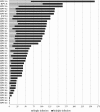Multiple human papillomavirus infections and type competition in men
- PMID: 22058418
- PMCID: PMC3242748
- DOI: 10.1093/infdis/jir709
Multiple human papillomavirus infections and type competition in men
Abstract
Background: There is little information on multiple human papillomavirus (HPV) infections and the potential for type competition in men, yet competition may impact the type-specific efficacy of HPV vaccination.
Methods: Among 2702 uncircumcised men in Kisumu, Kenya, who were seronegative for human immunodeficiency virus, the observed numbers of HPV types detected were compared with the expected number, which was simulated under the assumption of independent infections. To assess the potential for HPV type competition, adjusted odds ratios for pairwise combinations of prevalent HPV type infections were estimated using semi-Bayesian methods.
Results: Half of all men were HPV positive, of whom 57% had multiple HPV types. We observed men without HPV infection and with ≥4 HPV types more often than expected if infections were independent. No negative associations between individual HPV types were observed. HPV types 31, 39, 56, 58, and 59 were positively associated with both carcinogenic vaccine types HPV-16 and HPV-18 (2-sided P value <.05).
Conclusions: Men who were HPV infected were likely to test positive for >1 HPV type. Cross-sectional associations between individual HPV types were positive and did not appear to be type-specific. Thus, we did not identify HPV types that are candidates for potential HPV type competition in men.
Figures
References
-
- Walboomers JM, Jacobs MV, Manos MM, et al. Human papillomavirus is a necessary cause of invasive cervical cancer worldwide. J Pathol. 1999;189:12–9. - PubMed
-
- Lajous M, Mueller N, Cruz-Valdez A, et al. Determinants of prevalence, acquisition, and persistence of human papillomavirus in healthy Mexican military men. Cancer Epidemiol Biomarkers Prev. 2005;14:1710–6. - PubMed
Publication types
MeSH terms
Substances
Grants and funding
LinkOut - more resources
Full Text Sources
Medical


